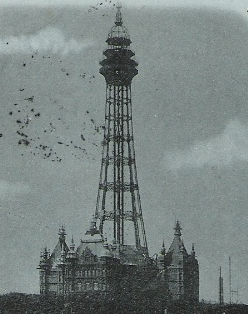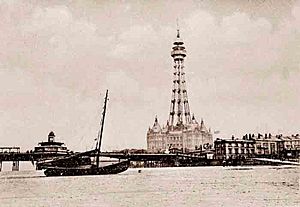New Brighton Tower facts for kids
Quick facts for kids New Brighton Tower |
|
|---|---|

New Brighton Tower and the four-storey red-brick Tower Building
|
|
| General information | |
| Status | Demolished |
| Type | Observation tower |
| Architectural style | Steel lattice design |
| Location | New Brighton, Wallasey, Cheshire (now Merseyside), England, UK |
| Coordinates | 53°26′12.37″N 3°02′11.03″W / 53.4367694°N 3.0363972°W |
| Completed | 1898–1900 |
| Demolished | Tower in 1919–21 and Tower Building in 1969 |
| Cost | £120,000 |
| Owner | New Brighton Tower and Recreation Company |
| Height | |
| Roof | 567 ft (173 m) |
| Technical details | |
| Floor count | 4 |
| Lifts/elevators | 4 |
| Design and construction | |
| Architect | Maxwell and Tuke |
| Developer | New Brighton Tower Estates Syndicate |
| Structural engineer | Andrew Handyside and Co. |
| Main contractor |
|
The New Brighton Tower was a huge steel tower in New Brighton, England. It was like a giant observation deck. When it opened between 1898 and 1900, it was the tallest building in Great Britain.
The tower stood 567 feet (173 m) high. Sadly, it was not looked after during World War I. The owners could not afford to fix it. So, the tower was taken down starting in 1919. Its metal was sold for scrap.
The building at the bottom of the tower had a ballroom. This building stayed open until a fire damaged it in 1969. The tower was part of a big park. This park had a boating lake, a funfair, gardens, and a sports ground.
Famous bands like The Beatles played at the Tower Ballroom many times. They played there 27 times. This was more than any other place in the UK, except for the Cavern Club in nearby Liverpool.
Contents
Where Was the Tower?
In 1830, a man named James Atherton bought land at Rock Point. This area was in Wallasey, across from Liverpool. He renamed it New Brighton. He wanted to make it a popular place for tourists.
In 1896, a new group called the New Brighton Tower and Recreation Company bought the land. They wanted to build a tower to compete with the Blackpool Tower. They also wanted to make the area feel more "elegant."
The company had over 20 acres (8 ha) of land. This allowed them to build more attractions than at Blackpool Tower.
Building the Tower
The company Maxwell and Tuke designed the tower. They had also designed the Blackpool Tower. William Clapham of Stockport dug the foundations for the tower. The main company that built the tower was Andrew Handyside and Company.
Work on the tower started on June 22, 1896. The steel tower itself began to be built in July 1897. It was finished between 1898 and 1900. The park grounds opened even earlier, in 1897.
The New Brighton Tower was the tallest building in England. It was 567 feet (173 m) tall. It stood 621 feet (189 m) above sea level. About 1,000 long tons (1,000 t) of steel was used to build it. This cost £120,000.
The building under the tower held the ballroom. It was built by Peters and Sons. It was a four-story red-brick building. It had arched windows and cool, copper-domed towers.
Sadly, six workers died while building the tower. Another worker was seriously hurt. A fire also happened on the tower in 1898. A firefighter died trying to put out the flames.
The Tower Building and Fun
The New Brighton Tower was known as "the highest structure and finest place of amusement in the Kingdom." You could pay one shilling to get into the park. This included the gardens, sports grounds, ballroom, and theatre. It cost an extra sixpence to go to the top of the tower.
The building had a small zoo with lions, wolves, bears, and other animals. There was also a bird house above the ballroom. You could also find a shooting gallery and a room with five billiard tables.
Going Up the Tower
The tower had four lifts. Each lift could reach the top in 90 seconds. They could carry up to 2000 people every hour. From the top, you could see the Liverpool skyline and the River Mersey. On a clear day, you could even see the Isle of Man and the Lake District.
In its first year, about half a million people went to the top of the tower. At night, the tower was lit up with many small lights.
One time, in 1909, two visitors were left at the top of the tower by mistake. A woman and a twelve-year-old child spent the night up there. They were found the next morning and seemed fine!
The Tower Ballroom
The ballroom had a special floor that bounced a little, perfect for dancing. It could hold over a thousand dancing couples. There was even a separate area for people to learn new dances. The ballroom was decorated in white and gold. It had balcony seats for people to watch.
A composer named Granville Bantock was the music director in 1897. He provided music for ballroom dancing for six hours every weekday. At first, he played outdoors while the tower was still being built. He said the noise of the tower being built reminded him of "anvil music."
Later, Bantock had a full orchestra. He started giving classical concerts on Fridays and Sundays. He even played his own music. But the management felt classical music was not making enough money. After three years, Bantock left.
Another famous composer, Edward Elgar, conducted his Enigma Variations at the ballroom in 1898. He also conducted Tchaikovsky's Pathétique symphony there in 1900.
In 1956, a fire destroyed the inside of the ballroom. But it was rebuilt to look just like it did before. It reopened two years later.
On November 10, 1961, The Beatles played at the New Brighton Tower Ballroom. About 4,000 people came to see them. Other bands like Gerry and the Pacemakers also played that night.
The Beatles played at the ballroom 27 times. This is remembered by a blue plaque in New Brighton. The only place they played more often in the UK was the Cavern Club. Other famous artists like Little Richard and the Rolling Stones also performed there.
The Tower Theatre
The Tower Theatre opened on May 30, 1898. It was located between the legs of the tower. It could hold 2,500 people. This made it the largest theatre in England outside of London.
The theatre showed different types of shows each year. Sometimes it was plays or operas. Other times, it had variety acts like magicians, comedians, and even a lion tamer with her seven lions! Wrestling matches were also held there often.
During World War II, American soldiers used the theatre. They put on their own shows for the troops.
Fun in the Grounds
The tower's park grounds were surrounded by iron railings. At night, the paths and gardens were lit up with 30,000 red, white, and green lights. The grounds had a bandstand, a dancing area, a fountain, and tennis courts. There were also pretty gardens with trees and flowers.
There was a lake in the grounds with a 130-foot (40 m) water slide. You could also ride in gondolas with Venetian gondoliers. There were many places to eat, like a Japanese restaurant, a Parisian Tea Garden, and an Algerian café.
The park also had a big funfair. Rides included the Figure of Eight, Wall Of Death, and The Caterpillar. A chair lift helped people get from the entrance to the tower easily.
Tower Athletic Ground
A special area in the park was called the Tower Athletic Ground. It had a stadium that opened in 1896. This was meant to give visitors more entertainment, especially in winter. The stadium could hold up to 100,000 people, though it rarely got that many.
The company that owned the tower also started a football team called New Brighton Tower F.C.. The team joined a league in 1897 and won it! They then joined the Football League. However, the team was stopped in 1901 because not enough fans came to watch.
The Tower Athletic Grounds was used for many sports. It had an athletics track and a banked cycle track. The World Cycling championships were held there in 1922. It was the biggest sports track in the North of England. In 1933, the athletics track was changed for motorcycle speedway racing every Saturday.
During World War II, the United States Army used the sports grounds. They stored military vehicles there for the invasion of France. After the war, the stadium reopened for another football team, New Brighton A.F.C..
Special Exhibitions
In 1900, the Tower Athletic Grounds hosted a group called The Ashanti Village. One hundred West African men, women, and children recreated an Ashanti village. They made and sold their crafts and performed "war tournaments" and "dances."
There was also a Bioscope exhibition. This showed the latest wartime pictures to audiences of up to 2,000 people. In 1907, there was a "Hale's Tours of the World" exhibition. This showed short films in a special railway carriage with sound effects and movements.
Why the Tower Closed
The tower closed in 1914 when World War I began. During the war, the steel tower was not looked after and became rusty. After the war, the owners could not afford to fix it.
People still argue about whether the tower was safe enough to be repaired. But demolition began in 1919. By 1921, only the ballroom building was left. The metal from the tower was sold to scrap dealers.
The New Brighton Tower was the tallest structure taken down in the UK for a long time.
On April 5, 1969, the ballroom building was destroyed by fire. No one knows what caused the fire. Today, where the tower and its grounds once stood, there is a new housing estate called River View Park. It has a community football pitch and a park.
Images for kids




